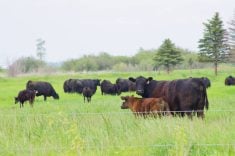Producers strive for a certain colour in their cattle.
This may be to meet breed standards, but certain colours can also imply an economic benefit.
Feeder cattle that are uniform in colour sell for a higher price than those less uniform. Producers can change the colour of their cattle by breeding certain ways.
Every cattle breed has basic body colours and sometimes they also have colour patterns. For example, Herefords have a red body and a white face. Some breeds have more than one body colour. Angus can be red or black.
Read Also

VIDEO: Ag in Motion documentary launches second season
The second season of the the Western Producer’s documentary series about Ag in Motion launched Oct. 8.
Cattle come in three basic colours: red, black and brownish-red to reddish-black. The latter colour is seen in the Jersey and Brown Swiss.
When we look at the genes that control coat colour, black is dominant to all other colours.
If an animal has at least one gene for black, it will be black.
Red is recessive so it can be expressed only if the animal possesses both genes for red. The brownish-red and reddish-black colour is between the two: recessive to black and dominant to red.
Mating a homozygous (possesses two genes) for black with a red animal (which must be homozygous for red) produces a calf with one black and one red gene. This calf will be black because that colour dominates.
If a calf with these two dissimilar genes is mated to a calf with the same genes, the offspring can be any combination of genes, but the offspring will be three-quarters black and one-quarter red.
There are also modifying genes. For example, a pair of dilution genes will dilute any colour to almost white or cream. Most solid white cattle are genetically black or red but have two dilution genes to dilute their pigmentation. Just one dilution gene, as well as one gene for non-dilution, can turn a black animal to grey.
A red animal with one dilution gene has a light yellow coat. Simmental, Charolais, Longhorn, Gelbvieh, Blonde d’Aquitaine, Murray Grey and Scottish Highland carry the dilution gene.
This dilution gene can be seen in action. Charolais cattle usually have two dilution genes. When mated to a Black Angus, the crossbreed will always be grey.
Similarly, white Simmental will dilute the colour of animals they are mated with, producing a paler calf.
Medium red-coloured Simmentals likely have just one dilution gene so when mated to other colours, they have a 50 percent chance of diluting the colours.
Producers who buy cattle at market are paying for animals based on expected performance, and to do this they look for breed characteristics.
Hereford, Polled Hereford and Simmentals have white faces or blaze-faces.
Brindling can be seen in Jerseys, Brown Swiss, Brahman, Chianina, Tarentaise and Longhorn.
Skunk-backs indicate Charolais or Pinzgauer.
Stocking legs come from Holstein, Beef Friesian, Maine Anjou, Simm-ental, Hays Converter, Hereford and Polled Hereford.
Droopy ears and larger navels are indications of Brahman, Brangus, Santa Gertrudis and Braford heritage.
Colour is not usually an economic trait by itself, but it can indicate important traits such as growth and carcass characteristics because experienced buyers can make a good estimate of the breed based on colour.
For example, buyers who consider a Hereford cross Angus to be a growthy mix look for black cattle with white faces. A grey calf could be a Charolais cross.
Some breeds were not mentioned in this article, but that doesn’t mean they are minor breeds. It means no colour inheritance is available for them.
















